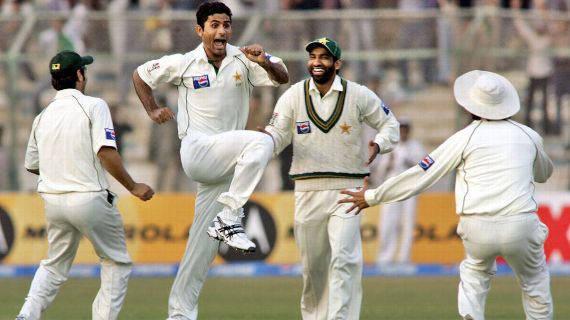Abdul Razzaq: Seven memories of the Pakistan allrounder

Abdul Razzaq is planning a return to top-flight cricket. Remember these days?
The greatest escape: 109* v South Africa, Dubai 2010
One of the great ODI innings, although by today’s batting standards, the numbers that define it look good but not unusual – 10 sixes in all, 150 chased off the last 20 having been five down, 100 off 70 balls, six sixes in the last four overs. Another way of looking at it might be to place it at the outset of the revolution of modern batting, where nothing is impossible. Which is a pretty good compliment – at his peak, and incongruously, Razzaq was a player from the future, the future we are living now.
Hat-trick hero: 3 for 35 v Sri Lanka, Galle 2000
In his youth, Razzaq was good enough to be first change for the Ws. He could generate healthy 140kph-type pace and was a mean reverser of the ball. Sri Lanka were favoured opponents (see later), as in Galle at the turn of the century. Razzaq had a 61-over-old ball in hand when he derailed the hosts’ first innings. Romesh Kaluwitharana and Rangana Herath were beaten by balls that reversed away (to a right-hander) and Ravindra Pushpakumara by one that tailed in sharply. None of them were yorkers, hinting at a broader range of reverse skills than Pakistanis are often credited for.

Desert storm: 5 for 31 v Sri Lanka, Sharjah 1999
Any Pakistani cricketer worth his salt must have created at least one night of magic in Sharjah. Few were as special as this, courtesy Razzaq. Sri Lanka were cruising at 173 for 2 in the 41st, needing just 24 to win. Shoaib Malik and Wasim Akram picked up three quick wickets, but they still needed just 14 from five overs with five wickets in hand. Razzaq, however, bowled three of the last five overs, taking 4 for 0 in nine balls. In nine balls – nippy, reversing in, hitting the stumps. He took the last wicket in the last over to tie the game.
Taming the Pidge: 40 v Australia, Sydney 2000
Five balls. Five fours. Pull, hoick, straight loft, pull again and a drive. Off the finest opposition bowler of his time. On his pitches. The end.
Saving Mohali: 71 v India, Mohali 2005
For all the batting fireworks, Razzaq could be a proper old-school Test grinder when he wanted. There was a seven-hour 87 against Walsh and Ambrose in Guyana and a six-hour 72 in the next Test. He made a Test hundred against England from one down, and of course, the infamous, befuddling 76-ball 4 at the MCG. But he could do it when the situation demanded, as here against India. Kamran Akmal joined him late on the fourth day, Pakistan effectively 39 for 6 and only the tail for company. The pair batted together for 56.1 overs, putting on 184 runs and easily saving the Test. Akmal got the plaudits for a counter-attacking maiden hundred, but Razzaq played the straight foil beautifully over nearly six hours.

World Champion: 3 for 20 v Sri Lanka, Lord’s 2009
It was after he was overlooked for the first World Twenty20(!) in 2007 that Razzaq’s discontent began, and from which his career never recovered. He joined the Indian Cricket League in anger, and was banned from playing for Pakistan as a result. By 2009, however, the ICL was gone and its players were returning back to the fold. Razzaq was the first, called up as a late replacement for the injured Yasir Arafat in the 2009 World T20. His impact was immediate, helping in a tournament-pivoting win against New Zealand. Shahid Afridi overshadowed him in the final, but it was Razzaq’s three top-order wickets – including one while memorably tumbling over in his follow-through – that set up the win.
The all-round package: 45 & 90, 3 for 67 & 4 for 88 v India, Karachi 2006
It was entirely in keeping with Razzaq’s late career that his greatest all-round Test performance is remembered instead for Kamran Akmal’s hundred and Mohammad Asif’s coming of age. It was Razzaq in the first innings who began the recovery from 39 for 6, adding a counter-punching 115 with Akmal that turned the day. It was his dismissal of Sachin Tendulkar, bowled by the perfect in-ducker in the way Razzaq had done him so often for a phase in 2000, that really set panic to India’s reply. He drove home the advantage in the second innings, before breaking through India’s middle-order resistance in their second innings. Remarkably, he had played his last Test before the year was out.



